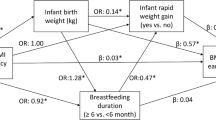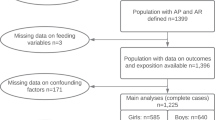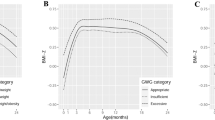Abstract
Background:
Longitudinal studies examining the potential mediating roles of birth weight and breastfeeding duration on the pathways between maternal gestational weight gain (GWG) and offspring anthropometric outcomes are lacking.
Methods:
We analyzed data from the mother–child pairs in the Infant Feeding Practices Study II (IFPS II) in late infancy (n=1548) and at the Year 6 Follow-up (n=1514) Study. Child anthropometrics included age- and sex-specific Z-scores for weight for age (WAZ), height /length for age, weight for height/length and body mass index (BMIZ). Structural equation models were used to estimate the total, direct and indirect effects of GWG on child anthropometrics through birth weight and breastfeeding duration.
Results:
The total effect of GWG on offspring anthropometric outcomes was significant for WAZ (β=0.107, 95% confidence interval (CI): 0.052, 0.161) at late infancy and for WAZ (β=0.122, 95% CI: 0.066, 0.177) and BMIZ (β=0.120, 95% CI: 0.063, 0.178) at 6 years old. The direct effects of GWG on offspring’s WAZ and BMIZ were observed only at 6 years old. The indirect effects of GWG through birth weight were significant on most of the offspring’s anthropometric measures. Compared to breastfeeding duration, birth weight was a stronger mediator on the pathways between GWG and all proposed anthropometric measures both in late infancy and in early childhood. Longer duration of breastfeeding was inversely associated with all offspring anthropometric outcomes at late infancy but not with those outcomes at 6 years old.
Conclusions:
Our findings suggest a stronger indirect rather than direct effect of GWG on children’s anthropometric outcomes mainly through birth weight, independent of maternal sociodemographic and reproductive factors. Longer duration of breastfeeding might suppress the positive relationship between GWG, birth weight and anthropometric outcomes in late infancy but not among 6 years old.
This is a preview of subscription content, access via your institution
Access options
Subscribe to this journal
Receive 12 print issues and online access
$259.00 per year
only $21.58 per issue
Buy this article
- Purchase on Springer Link
- Instant access to full article PDF
Prices may be subject to local taxes which are calculated during checkout

Similar content being viewed by others
References
de Onis M, Blossner M, Borghi E . Global prevalence and trends of overweight and obesity among preschool children. Am J Clin Nutr 2010; 92: 1257–1264.
Ng M, Fleming T, Robinson M, Thomson B, Graetz N, Margono C et al. Global, regional, and national prevalence of overweight and obesity in children and adults during 1980-2013: a systematic analysis for the Global Burden of Disease Study 2013. Lancet 2014; 384: 766–781.
World Health Organization. Available at http://www.who.int/end-childhood-obesity/facts/en/ (accessed on 14 September 2015).
World Health Organization. Available at http://www.who.int/end-childhood-obesity/news/echo-second-meeting/en/ (accessed on 14 September 2015).
Obstetricians ACo and Gynecologists. ACOG Committee opinion no. 549: obesity in pregnancy. Obstet Gynecol 2013; 121: 213.
Ogden CL, Carroll MD, Kit BK, Flegal KM . Prevalence of childhood and adult obesity in the United States, 2011-2012. JAMA 2014; 311: 806–814.
Hu F . Genetic predictors of obesity. Obes Epidemiol 2008; 437–460.
Ebbeling CB, Pawlak DB, Ludwig DS . Childhood obesity: public-health crisis, common sense cure. Lancet 2002; 360: 473–482.
Bammann K, Peplies J, De Henauw S, Hunsberger M, Molnar D, Moreno LA et al.Early life course risk factors for childhood obesity: the IDEFICS case-control study. PLoS ONE 2014; 9: e86914.
Wrotniak BH, Shults J, Butts S, Stettler N . Gestational weight gain and risk of overweight in the offspring at age 7 y in a multicenter, multiethnic cohort study. Am J Clin Nutr 2008; 87: 1818–1824.
Zhu Y, Hernandez LM, Dong Y, Himes JH, Hirschfeld S, Forman MR . Longer breastfeeding duration reduces the positive relationships among gestational weight gain, birth weight and childhood anthropometrics. J Epidemiol Commun Health 2015; 69: 632–638.
Hinkle SN, Sharma AJ, Swan DW, Schieve LA, Ramakrishnan U, Stein AD . Excess gestational weight gain is associated with child adiposity among mothers with normal and overweight prepregnancy weight status. J Nutr 2012; 142: 1851–1858.
Hooper D, Coughlan J, Mullen M . Structural equation modelling: guidelines for determining model fit. Articles 2008; 2.
Tie HT, Xia YY, Zeng YS, Zhang Y, Dai CL, Guo JJ et al. Risk of childhood overweight or obesity associated with excessive weight gain during pregnancy: a meta-analysis. Archives of gynecology and obstetrics 2014; 289: 247–257.
Lau EY, Liu J, Archer E, McDonald SM, Liu J . Maternal weight gain in pregnancy and risk of obesity among offspring: a systematic review. Journal of obesity 2014; 2014: 524939.
Beyerlein A, Nehring I, Rzehak P, Heinrich J, Muller MJ, Plachta-Danielzik S et al. Gestational weight gain and body mass index in children: results from three german cohort studies. PLoS ONE 2012; 7: e33205.
Branum AM, Parker JD, Keim SA, Schempf AH . Prepregnancy body mass index and gestational weight gain in relation to child body mass index among siblings. Am J Epidemiol 2011; 174: 1159–1165.
Ehrenthal DB, Maiden K, Rao A, West DW, Gidding SS, Bartoshesky L et al. Independent relation of maternal prenatal factors to early childhood obesity in the offspring. Obstet Gynecol 2013; 121: 115–121.
Deierlein AL, Siega-Riz AM, Adair LS, Herring AH . Effects of pre-pregnancy body mass index and gestational weight gain on infant anthropometric outcomes. J Pediatr 2011; 158: 221–226.
Deierlein AL, Siega-Riz AM, Herring AH, Adair LS, Daniels JL . Gestational weight gain and predicted changes in offspring anthropometrics between early infancy and 3 years. Pediatr Obes 2012; 7: 134–142.
Hilson JA, Rasmussen KM, Kjolhede CL . Excessive weight gain during pregnancy is associated with earlier termination of breast-feeding among White women. J Nutr 2006; 136: 140–146.
Winkvist A, Brantsaeter AL, Brandhagen M, Haugen M, Meltzer HM, Lissner L . Maternal prepregnant body mass index and gestational weight gain are associated with initiation and duration of breastfeeding among Norwegian mothers. J Nutr 2015; 145: 1263–1270.
Gillman MW, Rifas-Shiman SL, Camargo CA Jr, Berkey CS, Frazier AL, Rockett HR et al. Risk of overweight among adolescents who were breastfed as infants. JAMA 2001; 285: 2461–2467.
Mayer-Davis EJ, Rifas-Shiman SL, Zhou L, Hu FB, Colditz GA, Gillman MW . Breast-feeding and risk for childhood obesity: does maternal diabetes or obesity status matter? Diabetes Care 2006; 29: 2231–2237.
Yan J, Liu L, Zhu Y, Huang G, Wang PP . The association between breastfeeding and childhood obesity: a meta-analysis. BMC Public Health 2014; 14: 1267.
Mgutshini NL Gestational weight gain and the risk of obesity among preschool children: is this mediated through birth weight? 2014. Available at http://scholarcommons.sc.edu/cgi/viewcontent.cgi?article=3687&context=etd.
Yu Z, Han S, Zhu G, Zhu C, Wang X, Cao X et al. Birth weight and subsequent risk of obesity: a systematic review and meta‐analysis. Obes Rev 2011; 12: 525–542.
Fein SB, Labiner-Wolfe J, Shealy KR, Li R, Chen J, Grummer-Strawn LM . Infant Feeding Practices Study II: study methods. Pediatrics 2008; 122 (Suppl 2): S28–S35.
Fein SB, Li R, Chen J, Scanlon KS, Grummer-Strawn LM . Methods for the year 6 follow-up study of children in the Infant Feeding Practices Study II. Pediatrics 2014; 134 (Suppl 1): S4–S12.
Taveras EM, Rifas-Shiman SL, Sherry B, Oken E, Haines J, Kleinman K et al. Crossing growth percentiles in infancy and risk of obesity in childhood. Arch Pediatr Adolesc Med 2011; 165: 993–998.
The Centers for Disease Prevention and Control. A SAS Program for the 2006 WHO Growth Charts. Available at http://www.cdc.gov/nccdphp/dnpao/growthcharts/resources/sas.htm (accessed on 11 January 2016).
The Centers for Disease Prevention and Control. A SAS Program for the 2000 CDC Growth Charts. Available at http://www.cdc.gov/nccdphp/dnpao/growthcharts/resources/sas.htm (accessed on 11 Novermber 2015).
Centers for Disease Control and Prevention. Available at http://www.cdc.gov/nccdphp/dnpao/growthcharts/resources/sas-who.htm (accessed on 27 April 2016).
Centers for Disease Control and Prevention. Available at http://www.cdc.gov/nccdphp/dnpao/growthcharts/resources/sas.htm (accessed on 27 April 2016).
Ebbeling CB, Pawlak DB, Ludwig DS . Childhood obesity: public-health crisis, common sense cure. Lancet 2002; 360: 473–482.
Han JC, Lawlor DA, Kimm SY . Childhood obesity. Lancet 2010; 375: 1737–1748.
Lytle LA . Examining the etiology of childhood obesity: The IDEA study. Am J Commun Psychol 2009; 44: 338–349.
Bagchi D . Global Perspectives on Childhood Obesity: Current Status, Consequences and Prevention. Academic Press: London, 2010.
Robinson SM, Crozier SR, Harvey NC, Barton BD, Law CM, Godfrey KM et al. Modifiable early-life risk factors for childhood adiposity and overweight: an analysis of their combined impact and potential for prevention. Am J Clin Nutr 2015; 101: 368–375.
Johnson L, Mander AP, Jones LR, Emmett PM, Jebb SA . Energy-dense, low-fiber, high-fat dietary pattern is associated with increased fatness in childhood. Am J Clin Nutr 2008; 87: 846–854.
Rodgers RF, Paxton SJ, Massey R, Campbell KJ, Wertheim EH, Skouteris H et al. Maternal feeding practices predict weight gain and obesogenic eating behaviors in young children: a prospective study. Int J Behav Nutr Phys Act 2013; 10: 24.
Doornweerd S, RG IJ, van der Eijk L, Neter JE, van Dongen J, van der Ploeg HP et al. Physical activity and dietary intake in BMI discordant identical twins. Obesity 2016; 24: 1349–1355.
Penney TL, Almiron-Roig E, Shearer C, McIsaac JL, Kirk SF . Modifying the food environment for childhood obesity prevention: challenges and opportunities. Proc Nutr Soc 2014; 73: 226–236.
Shrestha I, Sunuwar L, Bhandary S, Sharma P . Correlation between gestational weight gain and birth weight of the infants. Nepal Med Coll J 2010; 12: 106–109.
Catov JM, Abatemarco D, Althouse A, Davis EM, Hubel C . Patterns of gestational weight gain related to fetal growth among women with overweight and obesity. Obesity 2015; 23: 1071–1078.
Rogers I, Group E-BS . The influence of birthweight and intrauterine environment on adiposity and fat distribution in later life. Int J Obes Relat Metab Disord 2003; 27: 755–777.
Yu ZB, Han SP, Zhu GZ, Zhu C, Wang XJ, Cao XG et al. Birth weight and subsequent risk of obesity: a systematic review and meta-analysis. Obes Rev 2011; 12: 525–542.
Siega-Riz AM, Viswanathan M, Moos MK, Deierlein A, Mumford S, Knaack J et al. A systematic review of outcomes of maternal weight gain according to the Institute of Medicine recommendations: birthweight, fetal growth, and postpartum weight retention. Am J Obstet Gynecol 2009; 201: e1–e14.
Institute of Medicine Weight Gain During Pregnancy: Reexamining the Guidelines. National Academies Press: Washington, DC, USA 2009.
Crozier SR, Inskip HM, Godfrey KM, Cooper C, Harvey NC, Cole ZA et al. Weight gain in pregnancy and childhood body composition: findings from the Southampton Women's Survey. Am J Clin Nutr 2010; 91: 1745–1751.
Schack-Nielsen L, Michaelsen KF, Gamborg M, Mortensen EL, Sorensen TI . Gestational weight gain in relation to offspring body mass index and obesity from infancy through adulthood. Int J Obes 2010; 34: 67–74.
Author information
Authors and Affiliations
Corresponding author
Ethics declarations
Competing interests
The authors declare no conflict of interest.
Additional information
Supplementary Information accompanies this paper on International Journal of Obesity website
Supplementary information
Rights and permissions
About this article
Cite this article
Liu, J., Xu, X., Liu, J. et al. Association of maternal gestational weight gain with their offspring’s anthropometric outcomes at late infancy and 6 years old: mediating roles of birth weight and breastfeeding duration. Int J Obes 42, 8–14 (2018). https://doi.org/10.1038/ijo.2017.183
Received:
Revised:
Accepted:
Published:
Issue Date:
DOI: https://doi.org/10.1038/ijo.2017.183
This article is cited by
-
The role of gut micorbiome in obesity and diabetes
World Journal of Pediatrics (2019)
-
Associations between gestational weight gain and rate of infancy weight gain in Hawai‘i and Puerto Rico WIC participants
BMC Obesity (2018)



